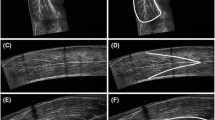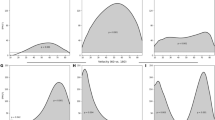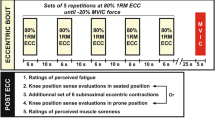Abstract
Purpose
The biarticular rectus femoris (RF), operating on the ascending limb of the force–length curve, produces more force at longer lengths. However, experimental studies consistently report higher knee extension torque when supine (longer RF length) compared to seated (shorter RF length). Incomplete activation in the supine position has been proposed as the reason for this discrepancy, but differences in antagonistic co-activation could also be responsible due to altered hamstrings length. We examined the role of agonist and antagonist muscles in explaining the isometric knee extension torque variation with changes in hip joint angle.
Method
Maximum voluntary isometric knee extension torque (joint MVC) was recorded in seated and supine positions from nine healthy males (30.2 ± 7.7 years). Antagonistic torque was estimated using EMG and added to the respective joint MVC (corrected MVC). Submaximal tetanic stimulation quadriceps torque was also recorded.
Result
Joint MVC was not different between supine (245 ± 71.8 Nm) and seated (241 ± 69.8 Nm) positions and neither was corrected MVC (257 ± 77.7 and 267 ± 87.0 Nm, respectively). Antagonistic torque was higher when seated (26 ± 20.4 Nm) than when supine (12 ± 7.4 Nm). Tetanic torque was higher when supine (111 ± 31.9 Nm) than when seated (99 ± 27.5 Nm).
Conclusion
Antagonistic co-activation differences between hip positions do not account for the reduced MVC in the supine position. Rather, reduced voluntary knee extensor muscle activation in that position is the major reason for the lower MVC torque when RF is lengthened (hip extended). These findings can assist standardising muscle function assessment and improving musculoskeletal modelling applications.



Similar content being viewed by others


References
Alon G (1985) High voltage stimulation. Effects of electrode size on basic excitatory responses. Phys Ther 65(6):890–895
Alon G, Kantor G, Ho HS (1994) Effects of electrode size on basic excitatory responses and on selected stimulus parameters. J Orthop Sports Phys Ther 20(1):29–35
Bampouras TM, Reeves ND, Baltzopoulos V, Jones DA, Maganaris CN (2012) Is maximum stimulation intensity required in the assessment of muscle activation capacity? J Electromyogr Kinesiol 22(6):873–877
Bampouras TM, Reeves ND, Baltzopoulos V, Maganaris CN (2017) Interplay between body stabilisation and quadriceps muscle activation capacity. J Electromyogr Kinesiol 34:44–49
Basmajian JV, De Luca CJ (1981) Muscles alive. Their function revealed by electromyography, 5th edn. Williams & Wilkins, Baltimore
Beltman JG, Sargeant AJ, Ball D, Maganaris CN, de Haan A (2003) Effect of antagonist muscle fatigue on knee extension torque. Pflugers Arch 446(6):735–741
Billot M, Simoneau EM, Ballay Y, Van Hoecke J, Martin A (2011) How the ankle joint angle alters the antagonist and agonist torques during maximal efforts in dorsi- and plantar flexion. Scand J Med Sci Sports 21(6):e273–e281
Button DC, Behm DG (2008) The effect of stimulus anticipation on the interpolated twitch technique. J Sports Sci Med 7(4):520–524
De Serres SJ, Enoka RM (1998) Older adults can maximally activate the biceps brachii muscle by voluntary command. J Appl Physiol 84(1):284–291
Delitto A, Strube MJ, Shulman AD, Minor SD (1992) A study of discomfort with electrical stimulation. Phys Ther 72(6):410–421
Faul F, Erdfelder E, Buchner A, Lang A-G (2009) Statistical power analyses using G*Power 3.1: tests for correlation and regression analyses. Behav Res Methods 41:1149–1160
Fritz CO, Morris PE, Richler JJ (2012) Effect size estimates: current use, calculations, and interpretation. J Exp Psychol Gen 141(1):2–18
Hart DL, Stobbe TJ, Till CW, Plummer RW (1984) Effect of trunk stabilization on quadriceps femoris muscle torque. Phys Ther 64(9):1375–1380
Herzog W, ter Keurs HE (1988) Force–length relation of in vivo human rectus femoris muscles. Pflügers Arch 411(6):642–647
Herzog W, Abrahamse SK, ter Keurs HE (1990) Theoretical determination of force–length relations of intact human skeletal muscles using the cross-bridge model. Pflügers Arch 416(1–2):113–119
Herzog W, Hasler E, Abrahamse SK (1991) A comparison of knee extensor strength curves obtained theoretically and experimentally. Med Sci Sports Exerc 23(1):108–114
Hoy MG, Zajac FE, Gordon ME (1990) A musculoskeletal model of the human lower extremity: the effect of muscle, tendon, and moment arm on the moment–angle relationship of musculotendon actuators at the hip, knee, and ankle. J Biomech 23(2):157–169
Kellis E, Baltzopoulos V (1999) The effects of the antagonist muscle force on intersegmental loading during isokinetic efforts of the knee extensors. J Biomech 32(1):19–25
Kubo K, Tsunoda N, Kanehisa H, Fukunaga T (2004) Activation of agonist and antagonist muscles at different joint angles during maximal isometric efforts. Eur J Appl Physiol 91:349–352
Lewek MD, Schmit BD, Hornby TG, Dhaher YY (2006) Hip joint position modulates volitional knee extensor muscle activity after stroke. Muscle Nerve 34(6):767–774
Lewis CL, Sahrmann SA, Moran DW (2009) Effect of position and alteration in synergist muscle force contribution on hip forces when performing hip strengthening exercises. Clin Biomech 24(1):35–42
Maffiuletti NA, Lepers R (2003) Quadriceps femoris torque and EMG activity in seated versus supine position. Med Sci Sports Exerc 35(9):1511–1516
Maganaris CN, Baltzopoulos V, Sargeant AJ (1998) Differences in human antagonistic ankle dorsiflexor coactivation between legs; can they explain the moment deficit in the weaker plantarflexor leg? Exp Physiol 83(6):843–855
Magnusson SP, Geismar RA, Gleim GW, Nicholas JA (1993) The effect of stabilization on isokinetic knee extension and flexion torque production. J Athl Train 28(3):221–225
McNair PJ, Marshall RN, Matheson JA (1991) Quadriceps strength deficit associated with rectus femoris rupture: a case report. Clin Biomech 6(3):190–192
Newman SA, Jones G, Newham DJ (2003) Quadriceps voluntary activation at different joint angles measured by two stimulation techniques. Eur J Appl Physiol 89:496–499
Reeves ND, Narici MV, Maganaris CN (2004) In vivo human muscle structure and function: adaptations to resistance training in old age. Exp Physiol 89(6):675–689
Rochette L, Hunter SK, Place N, Lepers R (2003) Activation varies among the knee extensor muscles during a submaximal fatiguing contraction in the seated and supine postures. J Appl Physiol 95(4):1515–1522
Rutherford OM, Jones DA, Newham DJ (1986) Clinical and experimental application of the percutaneous twitch superimposition technique for the study of human muscle activation. J Neurol Neurosurg Psychiatry 49(11):1288–1291
Simoneau EM, Longo S, Seynnes OR, Narici MV (2012) Human muscle fascicle behavior in agonist and antagonist isometric contractions. Muscle Nerve 45(1):92–99
Tyler AE, Hutton RS (1989) Was Sherrington right about co-contractions? Brain Res 370:171–175
Winter SL, Challis JH (2010) The force–length curves of the human rectus femoris and gastrocnemius muscles in vivo. J Appl Biomech 26(1):45–51
Acknowledgements
The study took place at the Muscle Function Laboratory, Manchester Metropolitan University. The study was financially supported by the Research and Scholarly Development Research Fund, University of Cumbria. No support was provided for the collection, analysis and interpretation of data; in the writing of the manuscript; and in the decision to submit the manuscript for publication.
Author information
Authors and Affiliations
Corresponding author
Ethics declarations
Conflict of interest
The authors declare they have no conflict of interest.
Additional information
Communicated by Olivier Seynnes.
Rights and permissions
About this article
Cite this article
Bampouras, T.M., Reeves, N.D., Baltzopoulos, V. et al. The role of agonist and antagonist muscles in explaining isometric knee extension torque variation with hip joint angle. Eur J Appl Physiol 117, 2039–2045 (2017). https://doi.org/10.1007/s00421-017-3693-y
Received:
Accepted:
Published:
Issue Date:
DOI: https://doi.org/10.1007/s00421-017-3693-y


